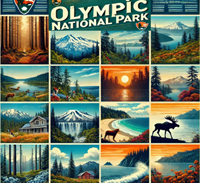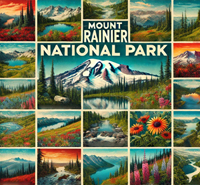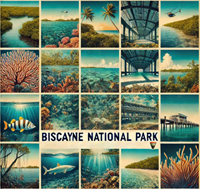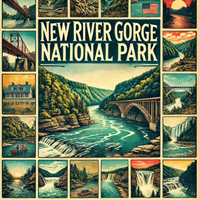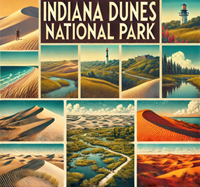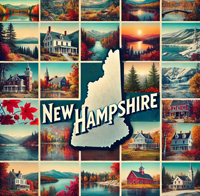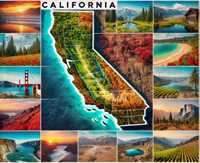
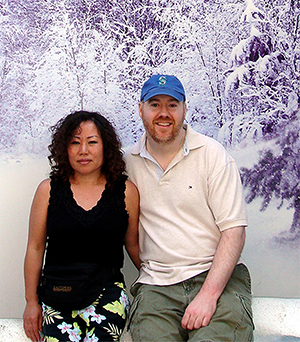
Embark on a journey curated by seasoned explorers William and Hui Cha Stanek, who have spent decades immersing themselves in the diverse landscapes of North America. These itineraries are more than just travel plans - they are thoughtfully crafted adventures designed to help you connect with the natural world, discover hidden gems, and create lasting memories.
National Parks Index | US Itineraries Index | American Roadtrips Index

Bring home a Bugville Critters book and watch as your child's love for reading and learning grows with every page. Hand-painted illustrations bring the heartwarming stories to life. Ask your librarian to add Bugville Critters to the library's digital collection today!
Discover William Stanek's Exclusive Art Collection
Explore and purchase the stunning art featured on this site. Own a piece of William Stanek's unique and captivating artwork today!
(May 2, 2025) Exploring Badlands and Wind Cave
Introduction: A 3-day Journey Through South Dakota's Hidden Wonders
There's something about the Great Plains that has always called to us – the endless horizons, the sense of space and solitude, and the unexpected beauty that reveals itself to those who take the time to look. Our journey through Badlands National Park and Wind Cave National Park in South Dakota was one that promised all of this and more. It was a chance to explore two vastly different landscapes, each with its own unique charm and history.
For Hui Cha, this trip was a chance to reconnect with the quiet beauty of nature. Growing up in the bustling city of Seoul, she often found herself longing for wide-open spaces and the kind of peace that can only be found in the great outdoors. South Dakota, with its vast prairies, rolling hills, and hidden caves, offered just that – a place where time seemed to slow down, and where the simple act of being in nature was enough to bring a sense of calm and contentment.
For me, William, it was an opportunity to capture the stark contrasts between these two parks – the rugged, eroded formations of the Badlands and the subterranean wonders of Wind Cave. Both parks presented their own set of challenges and rewards for a photographer, and I was eager to see what unique perspectives I could find in these less-traveled corners of the United States.
Our adventure through these two parks was not just about photography – it was about experiencing the deep sense of peace and connection that comes from being in such awe-inspiring places. From the dramatic landscapes of the Badlands to the intricate labyrinth of Wind Cave, this journey offered a profound connection to both the natural world and the rich history that shaped it.
In this guide, we'll take you through our detailed itineraries, share our best tips for capturing the unique beauty of these parks, and offer alternative activities for those seeking a less strenuous adventure. Whether you have just one day or a full three days to explore, this guide will help you make the most of your journey through these remarkable South Dakota landscapes.
Day 1: Discovering the Rugged Beauty of Badlands National Park
Morning: Sunrise at Big Badlands Overlook
6:00 AM - Sunrise at Big Badlands Overlook
Overview: Start your day in Badlands National Park with a sunrise at Big Badlands Overlook, one of the park's most iconic viewpoints. As the first light of day illuminates the eroded formations, the landscape comes alive with a palette of warm oranges, pinks, and purples. The contrast between the jagged ridges and the soft morning light creates a scene of otherworldly beauty.
Tips from William: "Arrive at least 30 minutes before sunrise to set up your shot. Use a wide-angle lens to capture the expansive view, and a tripod to ensure sharpness in the low light. The early morning light is soft and warm, perfect for bringing out the textures and layers of the Badlands formations. Focus on capturing the play of light and shadow as the sun rises."
Insights from Hui Cha: "The mornings can be chilly, even in the summer, so dress in layers and bring a thermos of hot coffee or tea. The quiet of the early morning, combined with the stunning views, creates a peaceful and reflective start to the day. Take a moment to simply enjoy the stillness before the park comes to life."
How to Access Big Badlands Overlook:
- Location: Big Badlands Overlook is located near the northeast entrance of Badlands National Park.
- Travel Directions: From the town of Wall, follow SD-240 (Badlands Loop Road) into the park. The overlook is about 5 miles from the park entrance and is well-marked with a parking area.
- Trail Details: The overlook is easily accessible from the parking area, with only a short walk required to reach the viewpoint.
Alternative Activity: Panorama Point
- If you prefer a slightly less crowded location, consider visiting Panorama Point for sunrise. This viewpoint offers similar expansive views of the Badlands formations and is located just a short drive from Big Badlands Overlook.
Photographic Techniques:
- Golden Hour Lighting: The soft, golden light of sunrise will enhance the warm tones of the rock formations. Use this light to highlight the textures and details of the Badlands.
- Wide-Angle Shots: Use a wide-angle lens to capture the full scope of the landscape, including the sweeping ridges and distant hills.
- Silhouettes: As the sun rises, the ridges and formations can create dramatic silhouettes against the colorful sky. Position yourself so that the sun is just behind a ridge to create a striking image.
Exploring the Area:
- After photographing Big Badlands Overlook, take a short drive to nearby overlooks like White River Valley Overlook and Burns Basin Overlook. Each offers unique perspectives of the Badlands and additional opportunities for morning photography.
Midday: Hiking the Notch Trail
10:00 AM - Notch Trail Hike
Overview: The Notch Trail is one of the most popular hikes in Badlands National Park, offering a short but adventurous journey through a scenic canyon to a breathtaking overlook. The trail includes a fun ladder climb and a walk along a narrow ledge, making it a favorite for those seeking a bit of adventure.
Tips from William: "The midday light can be harsh, so focus on capturing the textures and details of the rock formations. Use a mid-range zoom lens (24-70mm) to capture both the sweeping views and the close-up details. A polarizing filter can help reduce glare and enhance the colors of the rocks and sky. The overlook at the end of the trail offers a stunning view of the White River Valley, so be sure to bring a wide-angle lens as well."
Insights from Hui Cha: "This hike is short but involves some steep sections and narrow ledges, so wear sturdy shoes and bring plenty of water. The ladder climb adds a fun element to the hike, but take your time and be careful, especially if you're carrying camera gear. The view from the top is well worth the effort, offering a panoramic vista of the Badlands."
How to Access the Notch Trail:
- Location: The Notch Trail is located near the Window and Door Trails in the Cedar Pass area of Badlands National Park.
- Travel Directions: From Big Badlands Overlook, continue on Badlands Loop Road for about 10 miles until you reach the Cedar Pass area. The trailhead is well-marked and located near the parking area for the Window and Door Trails.
- Trail Details: The Notch Trail is a 1.5-mile round-trip hike with a moderate difficulty level. The trail includes a ladder climb and some narrow ledges, so be prepared for a bit of a challenge.
Alternative Activity: Door Trail
- For a less strenuous option, consider hiking the Door Trail. This 0.75-mile round-trip hike offers an easy walk through a break in the Badlands Wall, leading to a stunning view of the eroded formations.
Photographic Techniques:
- Leading Lines: Use the trail itself as a leading line to guide the viewer's eye through the image and towards the overlook.
- Rock Formations: Focus on the unique shapes and patterns in the rock, such as the layers of sediment and the weathered surfaces. These details can create interesting and abstract compositions.
- Wide-Angle Landscapes: The view from the top of the Notch Trail is perfect for wide-angle landscape photography. Include some foreground elements, such as the rock formations or vegetation, to add depth to your composition.
Exploring the Area:
- After your hike, consider exploring the nearby Window and Door Trails, which offer additional opportunities for photography and exploration. These short, easy trails provide stunning views of the Badlands formations and are a great way to continue your adventure.
Afternoon: Driving the Badlands Loop Road
1:30 PM - Badlands Loop Road Scenic Drive
Overview: The Badlands Loop Road (SD-240) is a 31-mile scenic drive that takes you through the heart of Badlands National Park, offering breathtaking views of the park's rugged landscape. The road winds through a series of overlooks, each providing a unique perspective of the eroded formations, deep canyons, and expansive prairies.
Tips from William: "The light in the afternoon can be harsh, but it's perfect for capturing the contrast between the bright sky and the dark shadows in the canyons. Use a polarizing filter to deepen the blue of the sky and reduce glare on the rocks. The road offers plenty of opportunities for photography, so take your time and stop at each overlook to explore different angles and compositions."
Insights from Hui Cha: "This drive is a peaceful way to explore the park without the need for strenuous hiking. Pack a picnic and stop at one of the many pullouts to enjoy the views and take a break. The road is well-maintained and easily navigable, making it accessible for all visitors."
How to Access Badlands Loop Road:
- Location: Badlands Loop Road (SD-240) runs through the northeastern section of Badlands National Park, connecting the town of Wall with the town of Interior.
- Travel Directions: From the Cedar Pass area, follow SD-240 east towards the town of Interior. The road offers numerous pullouts and overlooks along the way.
- Points of Interest: Key stops along the Badlands Loop Road include Bigfoot Pass Overlook, Pinnacles Overlook, and Yellow Mounds Overlook.
Alternative Activity: Sage Creek Rim Road
- For a more rugged experience, consider driving the Sage Creek Rim Road, an unpaved road that offers a quieter, more remote view of the Badlands and is known for its wildlife sightings, including bison and prairie dogs.
Photographic Techniques:
- Panoramic Shots: The sweeping vistas along the Badlands Loop Road are perfect for panoramic photography. Take multiple shots from left to right and stitch them together in post-processing to create a wide, sweeping view of the landscape.
- Telephoto Details: Use a telephoto lens to zoom in on distant details, such as the rocky outcrops or the patterns in the eroded formations. These close-ups can add variety to your landscape portfolio.
- Color and Contrast: The vibrant colors of the Badlands formations, combined with the deep blue of the sky, create striking images with strong color contrast. Use this to your advantage when composing your shots.
Exploring the Area:
- After driving the Badlands Loop Road, consider stopping at the Ben Reifel Visitor Center to learn more about the park's geology, wildlife, and history. The visitor center offers exhibits, a gift shop, and information about the park's many attractions.
Evening: Sunset at Pinnacles Overlook
6:30 PM - Pinnacles Overlook
Overview: End your day in Badlands National Park with a sunset at Pinnacles Overlook, one of the park's most iconic and accessible viewpoints. From here, you can see for miles in every direction, with the eroded formations and rolling prairies stretching out beneath the vibrant colors of the setting sun.
Tips from William: "Arrive about an hour before sunset to set up your shot. Use a wide-angle lens to capture the expansive view, and a graduated neutral density filter to balance the exposure between the bright sky and the darker foreground. As the sun sets, keep shooting to capture the changing colors of the sky and the deepening shadows over the landscape."
Insights from Hui Cha: "This is a peaceful spot to reflect on your day and take in the beauty of the park. Bring a light jacket, as it can get cool in the evening, and enjoy the quiet as the sun dips below the horizon. The views are breathtaking, and it's a perfect way to end your day in the Badlands."
How to Access Pinnacles Overlook:
- Location: Pinnacles Overlook is located near the western end of Badlands Loop Road.
- Travel Directions: From the town of Interior, follow SD-240 west for about 20 miles until you reach Pinnacles Overlook. The drive takes about 30 minutes.
- Trail Details: The overlook is easily accessible from the parking area, with only a short walk required to reach the viewpoint.
Alternative Activity: Conata Basin Overlook
- For a different sunset experience, consider visiting Conata Basin Overlook. This spot offers stunning views of the Badlands formations and is less crowded than Pinnacles Overlook.
Photographic Techniques:
- Golden Hour Lighting: The warm, golden light just before sunset is ideal for landscape photography. Use this light to highlight the contours of the formations and the rolling prairies.
- Silhouettes: As the sun sets behind the formations, the ridges and spires can create dramatic silhouettes against the colorful sky. Position yourself so that the sun is just behind a formation to create a striking image.
- Foreground Elements: Include some of the vegetation or rocks in the foreground to add depth and interest to your landscape shots.
Exploring the Area:
- After sunset, consider staying a bit longer for some stargazing. The night sky in Badlands National Park is incredibly clear, making it an excellent place for night photography. The view of the Milky Way rising above the formations is particularly stunning, and you can capture it in all its glory.
Day 2: Unveiling the Subterranean Mysteries of Wind Cave National Park
Morning: Exploring the Natural Entrance Tour
9:00 AM - Natural Entrance Tour
Overview: Start your day in Wind Cave National Park with the Natural Entrance Tour, a guided tour that takes you through some of the most impressive rooms and passageways in the cave. Wind Cave is one of the longest and most complex caves in the world, known for its unique boxwork formations, which are found in abundance along this route.
Tips from William: "Cave photography can be challenging due to the low light and tight spaces. Use a wide-angle lens to capture the full scope of the cave's features, and a tripod to stabilize your camera for longer exposures. Be mindful of the humidity in the cave, which can cause lens fogging – bring a lens cloth to keep your equipment dry."
Insights from Hui Cha: "The tour involves descending several hundred feet into the cave, so be prepared for cool temperatures and dim lighting. The guide will provide a wealth of information about the cave's geology and history, so take your time to absorb the experience. The beauty of the boxwork formations is truly something to behold – there's nothing else like it in the world."
How to Access the Natural Entrance Tour:
- Location: The Natural Entrance Tour begins at the Wind Cave Visitor Center.
- Travel Directions: From Badlands National Park, take SD-240 to I-90 West, then follow US-385 South to the Wind Cave Visitor Center. The drive takes about 1.5 hours.
- Tour Details: The Natural Entrance Tour lasts about 1.5 hours and covers 2/3 mile of cave passageways. The tour is suitable for most visitors, but it involves steep stairs and low ceilings, so be prepared for some physical activity.
Alternative Activity: Garden of Eden Tour
- For a shorter, less strenuous tour, consider the Garden of Eden Tour. This 1-hour tour explores a smaller section of the cave but still offers stunning views of the cave's unique formations.
Photographic Techniques:
- Long Exposures: The low light in the cave requires longer exposures, so use a tripod and set your camera to a high ISO (1600 or above) to capture the details of the formations.
- Wide-Angle Shots: Use a wide-angle lens to capture the full scope of the cave's rooms and passageways, including the intricate boxwork formations.
- Detail Shots: Focus on the unique textures and patterns of the boxwork and other formations. These close-ups can create abstract, almost otherworldly images.
Exploring the Area:
- After your tour, take some time to explore the exhibits at the Wind Cave Visitor Center, which offer additional information about the cave's geology, history, and the wildlife that inhabit the park.
Midday: Hiking the Rankin Ridge Trail
12:00 PM - Rankin Ridge Trail Hike
Overview: The Rankin Ridge Trail is a short but rewarding hike that takes you to the highest point in Wind Cave National Park, offering panoramic views of the surrounding landscape. The trail winds through ponderosa pine forests and open meadows, providing a peaceful and scenic way to experience the park above ground.
Tips from William: "The midday light can be harsh, so focus on capturing the textures and details of the landscape. Use a mid-range zoom lens to capture both the sweeping views and the close-up details of the plants and rocks. The view from the top of the ridge offers a stunning panorama of the Black Hills, so be sure to bring a wide-angle lens as well."
Insights from Hui Cha: "This hike is short but involves some elevation gain, so wear sturdy shoes and bring plenty of water. The trail is well-marked and easy to follow, making it a great option for families or those looking for a less strenuous hike. The views from the top are well worth the effort, offering a 360-degree panorama of the park and beyond."
How to Access the Rankin Ridge Trail:
- Location: The trailhead for the Rankin Ridge Trail is located near the Wind Cave Visitor Center.
- Travel Directions: From the visitor center, follow signs for Rankin Ridge. The trailhead is located about 5 miles from the visitor center.
- Trail Details: The Rankin Ridge Trail is a 1-mile loop with a moderate difficulty level. The trail includes some steep sections, but the path is well-maintained and suitable for most hikers.
Alternative Activity: Lookout Point Trail
- For a longer hike, consider the Lookout Point Trail, a 3.5-mile loop that offers beautiful views of the prairies and forests of Wind Cave National Park.
Photographic Techniques:
- Wide-Angle Landscapes: The view from the top of Rankin Ridge is perfect for wide-angle landscape photography. Include some foreground elements, such as the trees or rocks, to add depth to your composition.
- Telephoto Details: Use a telephoto lens to zoom in on distant details, such as the rolling hills or the patches of forest. These close-ups can add variety to your landscape portfolio.
- Golden Hour: If you time your hike to arrive at the top of the ridge just before sunset, you'll be rewarded with the soft, golden light of the late afternoon. This light is ideal for capturing the warm tones of the landscape and the cool blues of the distant hills.
Exploring the Area:
- After your hike, consider stopping at the nearby Cold Brook Canyon Trail, a short, easy trail that offers additional opportunities for photography and exploration. The trail winds through a scenic canyon and is a great place to spot wildlife.
Afternoon: Exploring the Prairie Dog Town
2:00 PM - Prairie Dog Town Exploration
Overview: Wind Cave National Park is home to several prairie dog towns, where you can observe these curious creatures as they go about their daily activities. The prairie dog towns are located in the park's open grasslands, providing a unique opportunity to see wildlife up close in their natural habitat.
Tips from William: "Prairie dogs are active during the day, especially in the early afternoon, making this the perfect time to capture their behavior. Use a telephoto lens to get close to the action without disturbing the animals. A fast shutter speed is essential for capturing the quick movements of the prairie dogs, so set your camera to a high ISO (800 or above) and use a shutter speed of 1/1000 or faster."
Insights from Hui Cha: "Watching the prairie dogs is a delightful way to spend the afternoon. Their social interactions and playful behavior are fascinating to observe. Be sure to keep a respectful distance to avoid stressing the animals, and enjoy the experience of seeing these iconic creatures in their natural environment."
How to Access Prairie Dog Town:
- Location: Prairie dog towns can be found throughout Wind Cave National Park, particularly in the open grasslands near the park's main roads.
- Travel Directions: From the Rankin Ridge Trail, follow US-385 South towards the southern part of the park. Look for signs indicating prairie dog towns, or ask a park ranger for directions to the nearest town.
- Exploration Details: There are no formal trails in the prairie dog towns, but you can explore the area on foot. Be sure to stay on the designated paths and avoid disturbing the animals.
Alternative Activity: Bison Viewing
- For a different wildlife experience, consider driving through the park's bison range. Wind Cave National Park is home to a large herd of bison, and the open grasslands provide excellent opportunities for viewing and photographing these majestic animals.
Photographic Techniques:
- Wildlife Photography: Use a telephoto lens (200mm or longer) to get close to the prairie dogs without disturbing them. A fast shutter speed is essential for capturing their quick movements.
- Behavioral Shots: Focus on capturing the interactions between the prairie dogs, such as grooming, playing, or communicating with each other. These shots tell a story about the social life of the prairie dogs and add depth to your wildlife portfolio.
- Environmental Portraits: Include some of the surrounding grasslands or distant hills in your shots to give context to the prairie dogs' habitat. These environmental portraits can help convey the scale and beauty of the park.
Exploring the Area:
- After exploring the prairie dog town, consider taking a scenic drive through the park to spot other wildlife, such as bison, elk, and pronghorn. Wind Cave National Park is home to a diverse array of animals, and the open grasslands provide excellent opportunities for wildlife viewing and photography.
Evening: Sunset at Lookout Point
6:30 PM - Lookout Point
Overview: End your day in Wind Cave National Park with a sunset at Lookout Point, one of the park's most scenic viewpoints. From here, you can see for miles across the rolling hills and prairies, with the setting sun casting a warm glow over the landscape. The peaceful atmosphere and stunning views make Lookout Point the perfect spot to reflect on your day in the park.
Tips from William: "Arrive about an hour before sunset to set up your shot. Use a wide-angle lens to capture the expansive view, and a graduated neutral density filter to balance the exposure between the bright sky and the darker foreground. As the sun sets, keep shooting to capture the changing colors of the sky and the deepening shadows over the hills."
Insights from Hui Cha: "This is a peaceful spot to reflect on your day and take in the beauty of the park. Bring a light jacket, as it can get cool in the evening, and enjoy the quiet as the sun dips below the horizon. The views are breathtaking, and it's a perfect way to end your day in Wind Cave."
How to Access Lookout Point:
- Location: Lookout Point is located near the southern end of Wind Cave National Park.
- Travel Directions: From Prairie Dog Town, follow US-385 South towards the southern end of the park. Lookout Point is well-marked and located near the road.
- Trail Details: The overlook is easily accessible from the parking area, with only a short walk required to reach the viewpoint.
Alternative Activity: Boland Ridge Overlook
- For a different sunset experience, consider visiting Boland Ridge Overlook. This spot offers a stunning view of the park's rolling hills and is less crowded than Lookout Point.
Photographic Techniques:
- Golden Hour Lighting: The warm, golden light just before sunset is ideal for landscape photography. Use this light to highlight the contours of the hills and the grasses.
- Silhouettes: As the sun sets behind the hills, the ridges and trees can create dramatic silhouettes against the colorful sky. Position yourself so that the sun is just behind a hill to create a striking image.
- Foreground Elements: Include some of the vegetation or rocks in the foreground to add depth and interest to your landscape shots.
Exploring the Area:
- After sunset, consider staying a bit longer for some stargazing. The night sky in Wind Cave National Park is incredibly clear, making it an excellent place for night photography. The view of the Milky Way rising above the hills is particularly stunning, and you can capture it in all its glory.
Day 3: Connecting the Parks and Capturing the Final Moments
Morning: Revisiting Big Badlands Overlook for Sunrise
6:00 AM - Big Badlands Overlook
Overview: Return to Badlands National Park for a second sunrise at Big Badlands Overlook, this time with the benefit of familiarity. With your previous experience, you can experiment with different compositions and techniques that you may have missed on your first visit.
Tips from William: "This time, focus on capturing the subtle changes in the light as the sun rises. Use a wide-angle lens to capture the entire scene, and a telephoto lens to zoom in on the details of the formations. The morning light can create beautiful, long shadows that add depth and interest to your images."
Insights from Hui Cha: "Returning to a location can offer a deeper connection to it. Take this opportunity to explore different angles and perspectives, and to notice the subtle changes in the light and atmosphere that make each visit unique."
How to Access Big Badlands Overlook:
- Location: Same as Day 1 – Big Badlands Overlook is located near the northeast entrance of Badlands National Park.
- Travel Directions: Follow the same route as before to reach the Big Badlands Overlook parking area.
- Trail Details: The overlook remains the same – easily accessible with only a short walk required to reach the viewpoint.
Photographic Techniques:
- Morning Light: The soft, golden light just after sunrise is ideal for capturing the warm tones of the rock formations and the surrounding landscape. Adjust your white balance to enhance these colors.
- Detail Shots: Focus on the intricate details of the formations, such as the layers of sediment and the weathered surfaces. These close-ups can add variety to your images and tell a deeper story about the site.
- Wide-Angle Landscapes: The sweeping ridges and distant hills provide a beautiful backdrop for your sunrise shots. Use a wide-angle lens to capture the full scope of the landscape.
Exploring the Area:
- After photographing Big Badlands Overlook, consider exploring the nearby Pinnacles Overlook, which offers additional opportunities for photography and exploration.
Midday: Driving the Scenic Wildlife Loop Road
11:00 AM - Wildlife Loop Road Scenic Drive
Overview: Spend your late morning driving along the Wildlife Loop Road in Custer State Park, located just south of Wind Cave National Park. This scenic drive offers breathtaking views of the Black Hills and is home to a variety of wildlife, including bison, pronghorn, and bighorn sheep. The road winds through rolling hills and open grasslands, providing a peaceful and scenic way to explore the area.
Tips from William: "The Wildlife Loop Road is a great place to practice wildlife photography from the comfort of your car. Use a telephoto lens to get close to the action without disturbing the animals, and a polarizing filter to reduce glare and enhance the colors of the landscape. The road offers plenty of opportunities for photography, so take your time and stop at each overlook to explore different angles and compositions."
Insights from Hui Cha: "This drive is a peaceful way to explore the area without the need for strenuous hiking. Pack a picnic and stop at one of the many pullouts to enjoy the views and take a break. The road is well-maintained and easily navigable, making it accessible for all visitors."
How to Access Wildlife Loop Road:
- Location: Wildlife Loop Road is located in Custer State Park, just south of Wind Cave National Park.
- Travel Directions: From Wind Cave, take US-385 South towards Custer State Park and follow signs for Wildlife Loop Road. The road offers numerous pullouts and overlooks along the way.
- Points of Interest: Key stops along the Wildlife Loop Road include the Buffalo Corrals, the French Creek Natural Area, and the Iron Mountain Road.
Alternative Activity: Needles Highway
- For a more rugged experience, consider driving the Needles Highway, a scenic byway that winds through the narrow tunnels and towering spires of the Black Hills.
Photographic Techniques:
- Wide-Angle Landscapes: The sweeping vistas along the Wildlife Loop Road are perfect for wide-angle landscape photography. Include the road itself as a leading line to draw the viewer's eye into the scene.
- Telephoto Details: Use a telephoto lens to zoom in on distant details, such as the rocky outcrops or the patches of forest and meadows. These close-ups can add variety to your landscape portfolio.
- Wildlife Photography: Use a telephoto lens (200mm or longer) to capture wildlife without disturbing them. A fast shutter speed is essential for capturing the quick movements of the animals, so set your camera to a high ISO (800 or above) and use a shutter speed of 1/1000 or faster.
Exploring the Area:
- After driving the Wildlife Loop Road, consider stopping for lunch in the nearby town of Custer, known for its historic charm and beautiful surroundings. The town offers several dining options and local shops, making it a great place to relax and unwind.
Afternoon: Exploring the Jewel Cave National Monument
2:00 PM - Jewel Cave National Monument
Overview: Jewel Cave National Monument, located just a short drive from Wind Cave, is the third-longest cave in the world, known for its stunning calcite formations, delicate crystals, and colorful flowstone. The cave offers a variety of guided tours, each taking you deep into the heart of this underground wonder.
Tips from William: "Cave photography can be challenging due to the low light and tight spaces. Use a wide-angle lens to capture the full scope of the cave's features, and a tripod to stabilize your camera for longer exposures. Be mindful of the humidity in the cave, which can cause lens fogging – bring a lens cloth to keep your equipment dry."
Insights from Hui Cha: "The tours involve descending several hundred feet into the cave, so be prepared for cool temperatures and dim lighting. The guide will provide a wealth of information about the cave's geology and history, so take your time to absorb the experience. The beauty of the calcite formations is truly something to behold – there's nothing else like it in the world."
How to Access Jewel Cave National Monument:
- Location: Jewel Cave National Monument is located about 13 miles west of Custer, South Dakota.
- Travel Directions: From Custer, take US-16 West towards Jewel Cave National Monument. The drive takes about 20 minutes.
- Tour Details: Jewel Cave offers several guided tours, ranging from easy walks to more strenuous explorations. The Scenic Tour is the most popular and offers a comprehensive overview of the cave's features.
Alternative Activity: Scenic Tour
- For a shorter, less strenuous experience, consider taking the Scenic Tour, a 1-hour walk through some of the most beautiful rooms in the cave.
Photographic Techniques:
- Long Exposures: The low light in the cave requires longer exposures, so use a tripod and set your camera to a high ISO (1600 or above) to capture the details of the formations.
- Wide-Angle Shots: Use a wide-angle lens to capture the full scope of the cave's rooms and passageways, including the intricate calcite formations.
- Detail Shots: Focus on the unique textures and patterns of the formations, such as the delicate crystals and the colorful flowstone. These close-ups can create abstract, almost otherworldly images.
Exploring the Area:
- After your tour, take some time to explore the exhibits at the Jewel Cave Visitor Center, which offer additional information about the cave's geology, history, and the wildlife that inhabit the park.
Evening: Stargazing at Badlands National Park
8:00 PM - Stargazing at Badlands National Park
Overview: End your adventure with a night under the stars at Badlands National Park. The park is known for its dark skies, making it one of the best places in South Dakota for stargazing. The vast prairie and rugged formations provide a dramatic backdrop for night photography, with the Milky Way stretching across the horizon.
Tips from William: "Use a wide-angle lens with a large aperture (f/2.8 or wider) to capture the night sky. A tripod is essential for long exposures – start with a 20-30 second exposure at ISO 3200 and adjust as needed. If you want to capture star trails, set your camera for an exposure of several minutes, or take multiple shorter exposures and stack them in post-processing."
Insights from Hui Cha: "There's something incredibly peaceful about sitting under the stars in the Badlands. Bring a blanket or camping chair, and just take a moment to appreciate the vastness of the universe. It's a perfect way to end your journey through these incredible parks."
How to Access the Stargazing Spots:
- Location: Badlands National Park offers numerous locations for stargazing, including Pinnacles Overlook, Big Badlands Overlook, and the Sage Creek Basin.
- Travel Directions: From Jewel Cave, head back towards Badlands National Park and follow signs for one of the overlooks. The drive takes about 1.5 hours.
- Viewing Points: Pinnacles Overlook, Big Badlands Overlook, and the Sage Creek Basin offer wide-open skies and minimal light pollution, making them ideal for stargazing.
Photographic Techniques:
- Milky Way Photography: Plan your session around the new moon to avoid light pollution. Use a wide-angle lens and set your ISO high (3200 or above) to capture the details of the Milky Way.
- Star Trails: To capture star trails, use a remote shutter release to minimize camera shake. Set your camera to bulb mode for exposures longer than 30 seconds. Alternatively, take multiple short exposures and stack them in post-processing to create the effect.
- Foreground Elements: Include some of the rock formations or prairie grass in the foreground to add depth and interest to your night sky images.
Exploring the Area:
- After your stargazing session, take a quiet drive back to your accommodations. The night sky will continue to accompany you on your journey, providing a serene and reflective end to your adventure.
Conclusion: A Journey Through South Dakota's Hidden Wonders
As we packed up our gear and began the drive back through the rolling hills and prairies, the night sky filled with stars, I felt a deep sense of peace and fulfillment. Our journey through Badlands and Wind Cave had been more than just a photographic adventure; it had been a journey through some of the most unique and awe-inspiring landscapes that South Dakota has to offer.
These parks are places where the natural world still reigns supreme, where the beauty of the land is matched only by the sense of peace that comes from being surrounded by such vast, untouched wilderness. From the rugged formations of the Badlands to the intricate underground wonders of Wind Cave, these landscapes offer a chance to connect with nature in a way that is both profound and humbling.
For us, this trip was a reminder of the importance of taking the time to explore and appreciate the natural world. It was a chance to capture the beauty of these places, to experience the peace that comes from being in such awe-inspiring surroundings, and to reconnect with each other and with ourselves.
As you embark on your own adventure through Badlands and Wind Cave, we hope that our insights and experiences will help you make the most of your journey. Take your time, respect the land, and let the beauty of these parks inspire you. And when you look back on your photographs, may they remind you not just of the places you visited, but of the moments you lived.
Happy travels, and may your journey through Badlands and Wind Cave be as rich and rewarding as ours.
Choosing Lodging for Your Adventure
Selecting the right lodging is key to making the most of your time in these distinct South Dakota landscapes. Here's a breakdown of lodging options that are strategically located to optimize your daily explorations, offering comfort, convenience, and proximity to key attractions:
Lodging Options Near Badlands National Park
Interior and Wall are the primary gateway towns to Badlands National Park, offering a range of accommodations that provide easy access to the park.
1. Cedar Pass Lodge (Inside Badlands National Park)
- Location: Inside Badlands National Park, near the Ben Reifel Visitor Center.
- Why It's Ideal: Staying at Cedar Pass Lodge places you right inside the park, allowing for easy access to the park's main attractions like the Badlands Loop Road, Notch Trail, and scenic overlooks. It's perfect for catching sunrise or sunset without a long drive.
- Amenities: Eco-friendly cabins with modern comforts, an on-site restaurant, and a gift shop featuring Native American crafts and local goods. The lodge offers direct access to the park's trails and viewpoints.
2. Badlands Inn
- Location: Near the Interior Entrance of Badlands National Park.
- Why It's Ideal: This inn offers comfortable accommodations with close proximity to the park entrance, making it convenient for early morning or late evening explorations. It's a budget-friendly option with great views of the Badlands.
- Amenities: Simple, clean rooms, continental breakfast, and stunning views of the Badlands from the property.
3. Frontier Cabins
- Location: Wall, about 8 miles from the Pinnacles Entrance of Badlands National Park.
- Why It's Ideal: Frontier Cabins offers rustic cabin accommodations with modern amenities, just a short drive from the Pinnacles Entrance. It's ideal for those looking for a more traditional and cozy lodging experience near the park.
- Amenities: Private cabins with porches, complimentary breakfast, a gift shop, and proximity to Wall Drug and other local attractions.
4. Badlands/White River KOA
- Location: Interior, about 5 miles from the Interior Entrance of Badlands National Park.
- Why It's Ideal: This campground offers a variety of lodging options, including cabins, RV sites, and tent camping, making it a versatile choice for different types of travelers. It's located close to the park, providing a convenient base for exploring.
- Amenities: Cabins, RV sites with full hookups, a swimming pool, laundry facilities, and a camp store.
5. Best Western Plains Motel
- Location: Wall, about 8 miles from the Pinnacles Entrance of Badlands National Park.
- Why It's Ideal: This modern motel offers comfortable accommodations with all the amenities you need after a day of exploring. It's a practical choice for those looking for a familiar and reliable place to stay near the park.
- Amenities: Comfortable rooms, indoor and outdoor pools, complimentary breakfast, and proximity to Wall's dining and shopping options.
Lodging Options Near Wind Cave National Park
Hot Springs is the closest town to Wind Cave National Park, offering a range of accommodations and easy access to the park's entrance.
1. Red Rock River Resort
- Location: Hot Springs, about 12 miles from the Wind Cave National Park entrance.
- Why It's Ideal: This historic resort offers a unique and luxurious stay with modern amenities and a touch of history. It's conveniently located for exploring both Wind Cave and the town of Hot Springs.
- Amenities: Elegant rooms, a full-service spa, a rooftop terrace, and proximity to local attractions like the Mammoth Site.
2. USA Stay Hotel and Suites
- Location: Hot Springs, about 12 miles from the Wind Cave National Park entrance.
- Why It's Ideal: This hotel offers modern, comfortable accommodations with easy access to both Wind Cave National Park and Custer State Park. It's a great base for exploring the surrounding Black Hills region.
- Amenities: Spacious rooms, indoor pool, hot tub, fitness center, and complimentary breakfast.
3. Hot Springs KOA
- Location: Hot Springs, about 10 miles from the Wind Cave National Park entrance.
- Why It's Ideal: This KOA offers a range of accommodations, from cabins to RV sites and tent camping, providing flexibility for different types of travelers. It's close to both Wind Cave and the amenities of Hot Springs.
- Amenities: Cabins, RV sites with full hookups, a swimming pool, a camp store, and easy access to nearby hiking trails.
4. The Historic Blue Jay Inn
- Location: Edgemont, about 20 miles from Wind Cave National Park.
- Why It's Ideal: This charming bed and breakfast offers a peaceful, historic stay with easy access to Wind Cave National Park. It's ideal for those looking for a more intimate and unique lodging experience.
- Amenities: Cozy, individually decorated rooms, complimentary breakfast, and a quiet, rural setting.
5. State Game Lodge (Custer State Park)
- Location: Custer State Park, about 18 miles from Wind Cave National Park.
- Why It's Ideal: This historic lodge offers a blend of rustic charm and modern comfort within Custer State Park, making it a great option if you plan to explore both Wind Cave and Custer State Park.
- Amenities: Lodge rooms and cabins, on-site dining, proximity to wildlife viewing areas, and access to hiking and scenic drives within Custer State Park.
Lodging Options Between Badlands and Wind Cave National Parks
Custer and Hill City are located roughly midway between Badlands and Wind Cave, offering convenient stopover points with access to the Black Hills and other attractions.
1. Custer State Park Resort
- Location: Custer State Park, central to both Badlands and Wind Cave.
- Why It's Ideal: This resort offers a variety of accommodations, from historic lodges to modern cabins, in a scenic setting within Custer State Park. It's a great midpoint stay for exploring both national parks and the surrounding Black Hills.
- Amenities: Multiple lodging options, on-site dining, outdoor activities, wildlife viewing, and proximity to scenic drives like the Needles Highway.
2. Holiday Inn Express & Suites Custer
- Location: Custer, about 30 miles from Wind Cave and 70 miles from Badlands.
- Why It's Ideal: This modern hotel offers comfortable accommodations with easy access to the attractions of Custer and the Black Hills. It's a good choice for a night's stay between the two parks.
- Amenities: Modern rooms, complimentary breakfast, indoor pool, hot tub, and proximity to Custer's dining and shopping options.
3. Black Hills Cabins & Motel at Quail's Crossing
- Location: Hill City, central to both Badlands and Wind Cave.
- Why It's Ideal: This property offers a variety of rustic cabins and motel rooms, providing a cozy and convenient stopover between your park adventures. It's located in the heart of the Black Hills, making it easy to explore nearby attractions.
- Amenities: Cabins and motel rooms, outdoor pool, picnic areas, and close proximity to Hill City's attractions and the Black Hills.
Tips for Choosing Lodging:
- Book Early: Lodging in the Badlands, Wind Cave, and surrounding Black Hills area can fill up quickly, especially during peak season (summer). Early booking is recommended.
- Consider Proximity: Staying close to the park entrances will maximize your time for exploration and reduce travel times.
- Balance Comfort and Access: Whether you prefer a rustic cabin, a modern hotel, or a historic lodge, choose accommodations that best fit your itinerary and travel style.
By selecting the right lodging options based on your itinerary, you'll be well-positioned to enjoy the full experience of Badlands and Wind Cave National Parks.
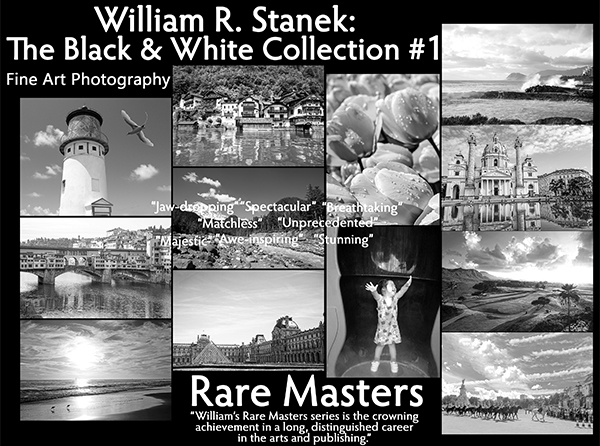
Step into a world of timeless beauty with our premium, oversized hardcover book - crafted for discerning collectors and anyone who values the power of art. Perfect for your coffee table, it's more than just a book; it's a conversation starter, a window into over 30 years of William's visionary photography.
Your Support Matters
Purchasing artwork from William Stanek's collection not only brings beauty into your life but also helps us continue to share. Thank you for supporting our creative journey!

Support The Lights of Paris by Robert Stanek, William Stanek's pen name! Through vivid historical detail and deeply moving character stories, Robert takes readers on an unforgettable journey through one of history’s most transformative times.


